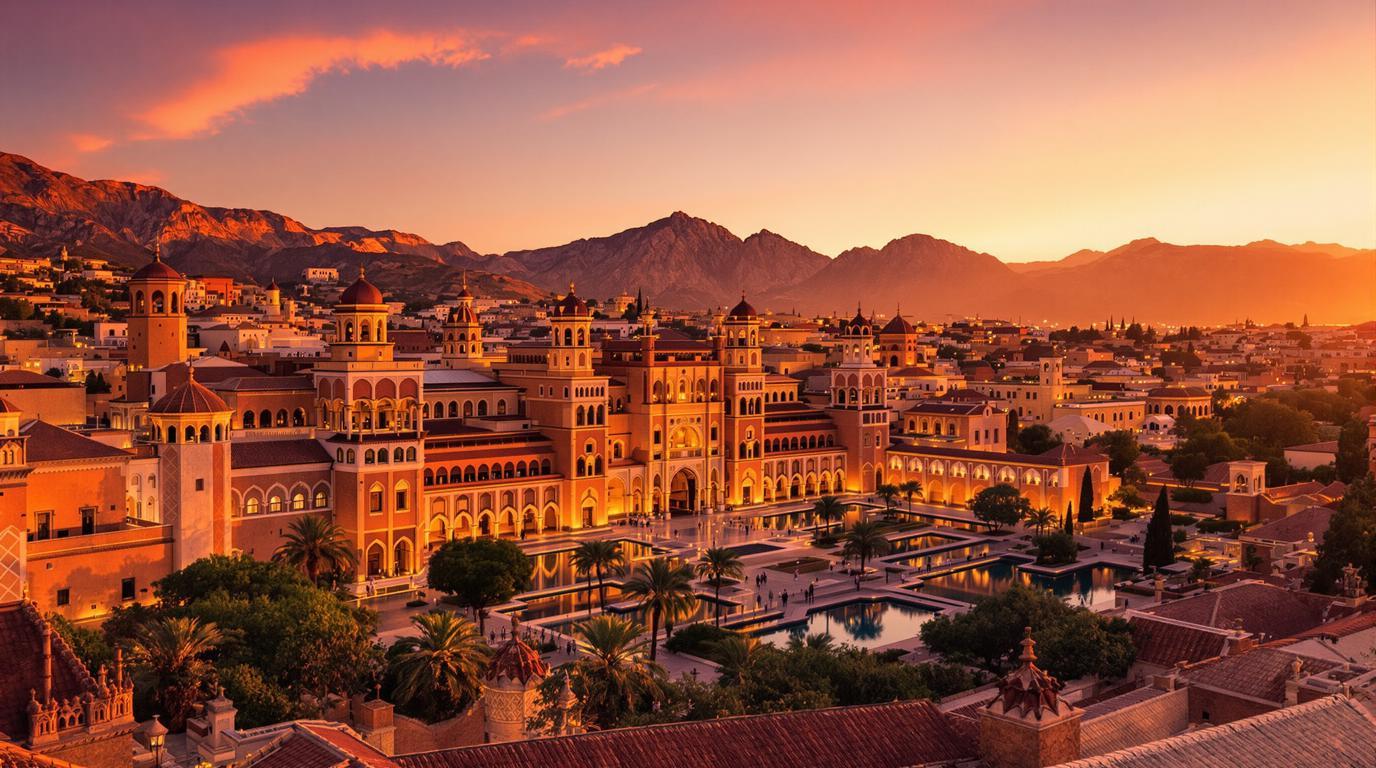The Alhambra Palace: Spain’s Red Fortress Where Islamic Art Reaches Its Zenith
A fortified masterpiece changing colors with the sun
As the rising sun bathes the Alhambra’s ochre-red walls in golden light, this 14th-century Islamic palace complex reveals why over 2.6 million visitors made the pilgrimage to Granada in 2023 alone. The name “Alhambra,” meaning “the red one” in Arabic, perfectly captures the fortress’s most distinctive feature – walls that transform from deep crimson to brilliant amber as daylight shifts across the Sierra Nevada mountains.
Unlike Peru’s Machu Picchu, where altitude challenges visitors, the Alhambra’s greatest hurdle is something entirely different: securing tickets. The Nasrid Palaces limit entry to just 300 visitors every 30 minutes, making advance booking absolutely essential.
Where mathematics and poetry merged in stone
Walking through the Court of the Lions, the mathematical precision of Islamic geometry unfolds in every direction. Intricate muqarnas (honeycomb vaults) adorn ceilings while azulejos (ceramic tiles) shimmer with mathematical patterns that would later influence computer algorithms.
“The Alhambra represents the pinnacle of Islamic architectural achievement in Europe. Every surface tells a story through mathematics, poetry, or botanical motifs,” explains María González, restoration specialist at the Alhambra Conservation Department.
Secret dawn rituals for photographers and history lovers
The savviest visitors book the first morning entry to the Nasrid Palaces, typically around 8:30 AM. This strategic timing offers two remarkable gifts: dramatically fewer crowds and ethereal light conditions as sunbeams filter through latticework windows, creating dappled patterns across marble floors.
While most tourists rush to the Court of Lions, seasoned travelers slip away to the forgotten Torre de la Cautiva (Tower of the Captive), where 360-degree views capture Granada’s whitewashed Albaicín district against the dramatic backdrop of the Sierra Nevada mountains.
The gardens that inspired countless writers
The Generalife Gardens, functioning as the sultans’ summer escape, showcase Islamic paradise gardens at their finest. Cypress-lined pathways frame reflective pools where water – the most precious resource in arid Andalusia – flows in elegant channels, creating a sensory symphony of gurgling sounds and cooling breezes.
These gardens deeply influenced Washington Irving, whose “Tales of the Alhambra” (1832) catapulted the then-neglected palace into international consciousness. Like Bali’s sacred temples, the Alhambra’s spaces feel spiritually charged despite centuries of religious and political transitions.
Granada’s free tapas tradition enhances the experience
After exploring the Alhambra’s vast complex, discover Granada’s unique food culture. Unlike most Spanish cities, Granada maintains a centuries-old tradition where every drink ordered comes with a complimentary tapa, creating an affordable feast.
“For the authentic Granada experience, visit Bar Bodegas Castañeda for vermouth and their legendary ham tapas. Watch how locals interact with bartenders – it’s a cultural performance,” recommends Antonio Martínez, local food historian.
Where to capture that perfect photograph
Photographers seeking the quintessential Alhambra image should head to Mirador San Nicolás in the Albaicín district at sunset. This viewpoint offers what many consider Spain’s most spectacular vista: the entire Alhambra complex glowing red against darkening mountains. The experience rivals watching sunset at Scotland’s singing beaches for pure natural drama.
A living reminder of cultural fusion
Beyond its architectural splendor, the Alhambra stands as testament to Andalusia’s multicultural golden age, when Islamic, Jewish, and Christian influences created extraordinary artistic and scientific achievements. Like France’s paleolithic caves, it connects visitors directly to pivotal moments in human creativity.
Standing beneath the impossibly delicate stalactite ceiling of the Hall of the Two Sisters, you can almost hear echoes of the poets, mathematicians, and philosophers who once gathered here, creating a civilization whose artistic legacy continues to astonish the world nine centuries later.
